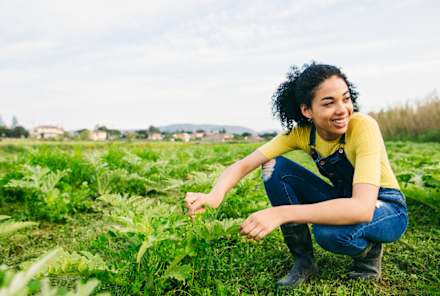Advertisement

Wellness is full of buzzwords and more diets, lifestyle plans, programs, and products than you can keep track of.
As many of the wellness-devotees among us know, nothing makes me happier than buying the latest cookbook or tasting the latest snack. (I love nutrition and wellness so much that I left my job as an attorney to become a dietitian—but that's a different story). But through diving deep into the world of nutrition, I've realized that there's no magic bullet when it comes to food.
I've long known that the more takeout or packaged foods I ate, the worse I felt. But in all honesty, how I feel isn't always enough to motivate me to consistently meal prep and pack my own snacks or refuse a tempting treat when I'm hungry. I'm not alone. Long-term health isn't always a strong enough motivator to change daily habits. We are bombarded with over 200 decisions about food every single day. Maybe you can avoid the occasional cupcake in the break room or candy at checkout, but saying "no" constantly is tiresome. And when you're exhausted after a long day, that convenient, pre-prepared meal often wins.
But a few years ago, I stumbled upon a secret to sticking with a diet that makes me feel amazing. And I didn't find it in a library book, doctor consult, or research study.
How one video changed my approach to eating.
When I turned upon Lauren Singer's TED talk Why I Live a Zero-Waste Life, I was shocked. Up until that point, I thought I lived an eco-friendly life, but in reality I had only scratched the surface. Lauren, who manages to fit all of her trash from the last four years into a single Mason jar, inspired me to try to cut back on my own trash production for the sake of the planet.
The first step in the project of reducing waste involved analyzing my trash. I faced the garbage in my life, literally and figuratively. Although I prided myself on my vegetable-heavy, nutrient-dense diet, I noticed that processed, packaged, and takeout food crept into my life more than I cared to admit. Plastic containers filled the recycling bin and stared back at me, reminding me of my lack of meal prep and preparedness for busy (and not-so-busy) weeks.

After the assessment, I started to get creative and challenged myself to reduce waste wherever I could. Instead of choosing between "healthy" and "unhealthy" foods, I was choosing between "packaged" and "unpackaged" ones.
As my garbage emptied, my fridge filled with real, whole foods. I became obsessed with decreasing waste. I tried to avoid packaged food (and products) altogether, opting to make my own meals and snacks using loose or bulk-bin ingredients as often as possible. This led me to finally develop habits and skills I had always wanted to: meal prepping and cooking regularly, cooking root to frond (using the whole vegetable in new, creative ways), and storing food appropriately to preserve nutrient quality. I also found myself eating more mindfully and making fewer impulsive food decisions.
Finally, I feel in control.
Enjoying homemade meals from my jar with my bamboo fork makes me feel better physically and emotionally. I feel empowered. I've discovered a framework for making the healthiest choices without obsessing about food. Finally, I feel in control.
Starting to reduce waste can seem daunting at first, but there's no rush! Here are a few suggestions to get you started. You might just find, like I did, that this becomes fun and addictive in the best sense.
1. Focus on staples.
The things we buy repeatedly add up the most, so find alternatives for as many of those staples as possible. What packaged goods do you buy every week? For instance, I used to buy packaged whole grains and nuts every week, but now, I go to the bulk section and get all those staples plastic- and package-free.
2. Ditch plastic produce bags.
Your avocado will make it from the supermarket to your home/apartment just fine. I promise!
3. Always have a glass jar with you and know its "tare" weight.
Most places allow you to fill up the jar with food and deduct the weight of the empty jar so you're only paying for the food itself.
4. Enjoy your coffee or meal to stay.
The first time I forgot my reusable coffee cup at home, I panicked when I needed a caffeine hit. Then I remembered that coffee shops have real cups. Remember those? They aren't just there for lovely Instagram photographs! And, let's be honest, even though we grab beverages to go, we usually down them quickly anyway. Why not take those five minutes, sit down at the café, and drink out of a real cup?
5. Rely on one-ingredient snacks.
For example, FRUIT. Buy fruit sans plastic and make it readily accessible on your counter or in the fridge to make it as accessible as packaged treats.
6. Allow for some wiggle room.
Cooking at home sounds great in theory, but it's not always glamorous, practical, or how I want to spend my Sunday. And it's a bit difficult to work up the motivation to make snacks in particular. Homemade crackers are delicious, but no matter how many I make, they seem to get eaten too quickly! Since getting frustrated with my husband for the speed at which he eats the delicious food I prepare is neither productive nor nice, we sometimes rely on convenient packaged snacks. But instead of automatically being swayed by clever advertising, I try to purchase packaged food much more mindfully and support companies committed to sustainable practices. And when we do dine out or take out, I try to always bring my own containers.
Now, three years into implementing these tips into my low-waste lifestyle, fad diets and new products have come and gone, but my commitment to myself and the environment persists.
Watch Next
Enjoy some of our favorite clips from classes
Enjoy some of our favorite clips from classes
What Is Meditation?
Mindfulness/Spirituality | Light Watkins
Box Breathing
Mindfulness/Spirituality | Gwen Dittmar
What Breathwork Can Address
Mindfulness/Spirituality | Gwen Dittmar
The 8 Limbs of Yoga - What is Asana?
Yoga | Caley Alyssa
Two Standing Postures to Open Up Tight Hips
Yoga | Caley Alyssa
How Plants Can Optimize Athletic Performance
Nutrition | Rich Roll
What to Eat Before a Workout
Nutrition | Rich Roll
How Ayurveda Helps Us Navigate Modern Life
Nutrition | Sahara Rose
Messages About Love & Relationships
Love & Relationships | Esther Perel
Love Languages
Love & Relationships | Esther Perel












